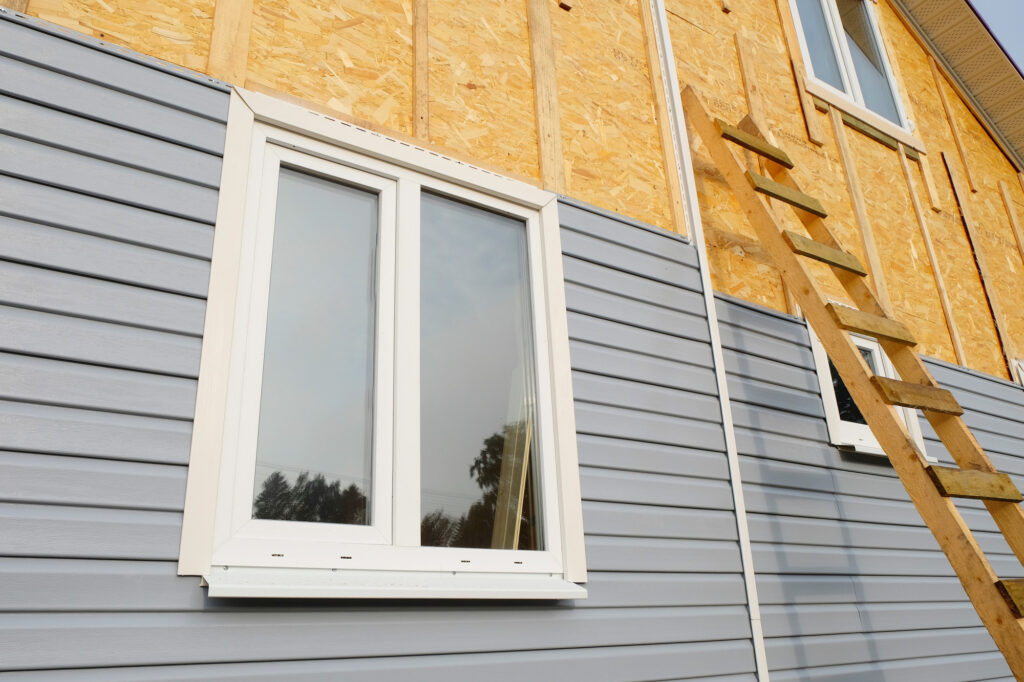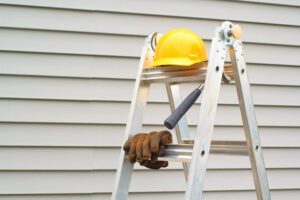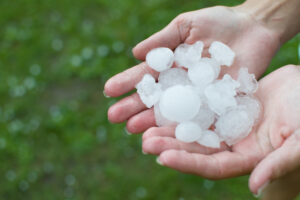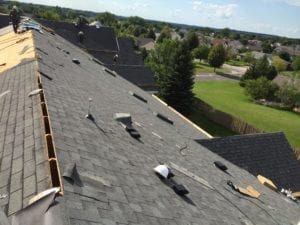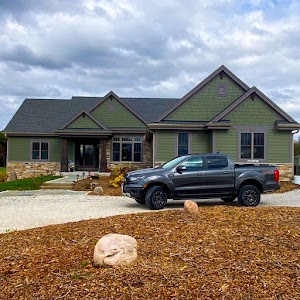Board and batten siding is a unique architectural style that features wide vertical boards and narrow battens, producing a textured and visually striking exterior. This design has roots in Nordic architecture and gained popularity in the U.S. during the mid-19th century. Homeowners appreciate its rustic charm, versatility in customization, and durability. Options include traditional wood, low-maintenance vinyl, and composite materials. Besides its aesthetic appeal, board and batten siding improves energy efficiency and can enhance property resale value. Exploring additional details on installation, costs, and design inspiration can provide deeper insights into this appealing siding option.
What is Board and Batten Siding?
Board and batten siding is an architectural style that features wide vertical boards and narrow battens, creating a unique textured appearance.
Emerging in the mid-19th century, its design reflects both historical influences and practical applications in home construction.
Today, homeowners are drawn to this siding for its aesthetic versatility and the ability to personalize their homes, while also considering its maintenance requirements.
Historical Background
Originating in the United States as a practical alternative to traditional log cabins, board and batten siding draws inspiration from Nordic European architecture, showcasing a unique combination of efficiency and aesthetic appeal.
This board and batten style features wide vertical boards complemented by narrow batten strips that cover the seams, creating a distinctive textured look.
Historically, it found popularity in agricultural structures, particularly barns, imparting a rustic charm that remains timeless.
By the mid-19th century, this siding became favored for residential homes, enhancing their exterior with both beauty and functionality.
Its ability to insulate against outdoor elements further solidified its appeal, ensuring that board and batten siding continues to connect with homeowners seeking a blend of tradition and modernity.
Why Homeowners Choose It Today
Many homeowners today are drawn to board and batten siding for its unique blend of rustic charm and modern versatility. This distinctive siding style enhances homes’ curb appeal, making it a popular choice for those seeking to raise their property’s aesthetic.
Board and batten siding offers exceptional design versatility, allowing homeowners to customize colors, spacing, and profiles to suit a variety of architectural styles, from classic to contemporary.
In addition, its low maintenance requirements make it an attractive option, as high-quality materials like fiber cement are resistant to warping, cracking, and pests.
Ultimately, board and batten siding combines durability and beauty, making it a favored choice for homeowners aiming to create a lasting impression with their exteriors.
Benefits of Board and Batten Siding
Board and batten siding presents several significant advantages that appeal to homeowners.
Its visual appeal enhances curb appeal while providing a rustic charm, complemented by durability and low maintenance requirements.
Furthermore, this siding option offers energy efficiency and a favorable cost-to-value ratio, making it a practical choice for various architectural styles.
Visual Appeal
The distinctive vertical pattern of board and batten siding creates an eye-catching texture that enhances the visual appeal of any home, making it a sought-after choice for diverse architectural styles.
This siding style adds significant visual interest, allowing homeowners to express their personal aesthetics through customizable batten widths and spacing.
The strong vertical lines not only contribute to the iconic board and batten look but also create an illusion of heightened ceilings, thereby elevating a home’s overall presence.
Moreover, the rustic charm of board and batten siding guarantees it maintains curb appeal for years, whether used as a full-home cladding or as an accent wall.
This versatility makes it an enduring favorite in both traditional and contemporary designs.
Durability & Maintenance
Constructed from high-quality materials, board and batten siding offers remarkable durability and requires minimal maintenance, making it a practical choice for homeowners seeking longevity and resilience in their exterior cladding.
This siding option can withstand harsh weather conditions and resists issues like rot, pests, and warping, ensuring it remains structurally sound for decades.
The robust nature of board and batten siding considerably enhances property value due to its attractive appearance and long-lasting performance.
In addition, low-maintenance materials such as vinyl and composite options do not fade easily, requiring less upkeep than traditional wood siding.
Regular installation and seasonal maintenance checks will additionally prolong the lifespan of board and batten siding, ensuring it continues to enhance the home’s aesthetic appeal.
Energy Efficiency
Enhancing energy efficiency, board and batten siding provides an effective solution for reducing heat loss in winter and minimizing heat gain during summer months.
The vertical design, along with proper installation techniques, minimizes air leaks and drafts, notably contributing to a more energy-efficient home.
Batten siding offers additional insulation capabilities, particularly when utilizing materials like fiber cement, which can improve thermal resistance.
Homeowners can expect a potential reduction in heating and cooling costs by 10-20% compared to less efficient siding options.
Seasonal maintenance, including sealing gaps and ensuring proper flashing, is crucial for sustaining its energy efficiency over time.
Ultimately, the investment in board and batten siding can yield long-term benefits, outweighing initial siding costs through reduced energy expenses.
Cost vs. Value
Cost considerations play a significant role in the decision-making process for homeowners evaluating the benefits of board and batten siding, particularly in relation to its long-term value.
While the installation costs range from $10.50 to $13.90 per square foot, translating to total expenses of $21,000 to $27,800 for a typical 2,000 sq. ft. home, the aesthetic appeal of board and batten siding can enhance property value.
Furthermore, low maintenance requirements and durable materials like fiber cement reduce upkeep costs over time.
Customizable designs and colors not only meet personal preferences but also increase resale value, making board and batten siding a smart investment that reflects a favorable cost vs. value ratio for homeowners.
Board and Batten Siding Options: Wood, Vinyl, and More
When selecting board and batten siding, homeowners often weigh the merits of wood versus vinyl options.
Wood offers a traditional aesthetic with a rustic charm but demands regular upkeep to maintain its integrity.
In contrast, vinyl siding presents a low-maintenance alternative, combining durability with cost-effectiveness, making it an appealing choice for many.
Comparing Wood vs. Vinyl
Choosing between wood and vinyl for board and batten siding involves weighing aesthetic appeal against maintenance requirements and long-term durability.
Wood siding offers a traditional, warm appearance but demands regular maintenance to prevent rot and pest damage. In contrast, vinyl siding serves as a low-maintenance alternative, requiring no painting or staining and proving to be more cost-effective, with installation averaging $7 to $10 per square foot compared to $10.50 to $13.90 for wood.
While high-quality vinyl is resistant to warping and fading, wood may require refinishing to maintain its charm. Both materials provide customization options, but vinyl may lack the authentic texture and variations inherent in natural wood.
Ultimately, the choice depends on individual preferences and long-term considerations.
Cost of Board and Batten Siding Installation
The cost of board and batten siding installation is influenced by various factors that homeowners should carefully consider.
Material selection, labor expenses, and additional components such as flashing and trim can greatly affect the overall budget.
Understanding these determinants will help in making informed decisions regarding this popular siding choice.
Factors Influencing Cost
Several factors influence the overall cost of board and batten siding installation, including material selection, labor expenses, and supplementary components necessary for a successful project.
The choice of materials greatly affects pricing, with options such as wood, vinyl, or composite ranging from $0.75 to over $10 per square foot.
Moreover, labor costs may rise due to customizations or the removal of existing siding, emphasizing the need for professional installation to achieve the best results.
Homeowners must also budget for essential components like flashing, moisture barriers, and trim, which contribute to the overall board and batten project expenses.
Understanding these factors guarantees informed decision-making when selecting exterior siding that aligns with both aesthetics and budget.
How to Install Board and Batten Siding (DIY Guide)
Installing board and batten siding can be a rewarding DIY project that enhances your home’s exterior.
This guide will provide a step-by-step approach to the installation process, along with essential tips for safety and efficiency.
Step-by-Step DIY Installation
How can homeowners achieve a stunning board and batten siding installation?
Start by preparing a level surface and removing any old siding, ensuring that the insulation and moisture barriers are intact.
Next, secure plywood sheets to the wall with a nail gun, placing multiple nails along each edge for stability and aligning seams for proper batten coverage.
Install the skirt using rot-resistant materials, applying longer nails for secure attachment.
Afterward, apply trim pieces around door and window openings, as well as at corners and edges, to create a polished finish.
DIY Tips & Safety
Proper preparation and attention to safety are paramount when commencing a DIY board and batten siding installation to guarantee both an aesthetically pleasing outcome and a secure work environment.
Begin by gathering essential tools, including a nail gun, measuring tape, and level, to streamline the installation process.
Prior to installation, remove any old siding and repair the underlying structure, ensuring a solid, level surface.
When installing plywood sheets, secure them with nails at stud locations, applying multiple nails along each edge for stability.
Maintain consistent spacing between battens for a cohesive look.
Always prioritize safety by wearing gloves, goggles, and a respirator mask during material handling and cutting, and utilize proper lifting techniques to avoid injury during the installation and maintenance phases.
Board and Batten Siding Ideas & Inspiration
Embracing the charm of board and batten siding can transform a home’s exterior, offering a unique blend of rustic appeal and modern versatility that allows for endless design possibilities.
This distinctive style creates strong vertical lines that enhance the look and feel of your home, making it suitable for traditional and contemporary aesthetics. Homeowners can customize batten width and spacing to achieve various effects, from a cozy cottage ambiance to a sleek, modern appearance.
Board and batten siding can be applied to the entire exterior of your home or used as striking accent walls, providing versatility.
Moreover, modern materials like engineered wood and fiber cement offer durability while maintaining aesthetic appeal, making it a practical choice for any homeowner.
Frequently Asked Questions
Is Board and Batten Cheaper Than Regular Siding?
The cost comparison between different siding options reveals that board and batten typically incurs higher installation expenses than regular siding. However, its long-term durability and low maintenance may provide financial benefits over time, warranting consideration.
What Are the Disadvantages of Board and Batten Siding?
The disadvantages include susceptibility to rot, warping, and insect damage if not maintained. Furthermore, installation costs can be high, and ongoing maintenance requirements may lead to increased long-term expenses compared to alternative siding options.
What Siding Is Used for Board and Batten?
Various materials are used for this siding style, including wood, vinyl, fiber cement, and engineered wood. Each option offers distinct aesthetic qualities and durability, allowing homeowners to select based on personal preferences and maintenance considerations.
How Expensive Is Board and Batten Siding?
The expense of siding installation varies considerably, generally ranging from $10.50 to $13.90 per square foot, influenced by material selection, labor costs, and additional components, with total costs for a typical home between $21,000 and $27,800.

